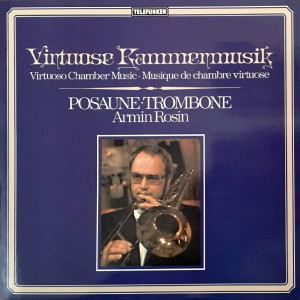 |
1 LP -
Telefunken 6.42828 AP (p) 1980
|
|
VIRTUOSE KAMMERMUSIK - Posaune
· Trombone
|
|
|
|
|
|
|
|
| Camille
Saint-Saëns (1835-1921) |
Cavatine
für Posaune und Klavier
Des-dur, Op. 144 (1916) |
|
4' 42" |
A1 |
|
- Allegro
· Andantino · Allegro |
|
|
|
| Carl Maria
von Weber (1786-1826) |
Romanze für
Posaune und Klavier c-moll |
|
7' 38" |
A2 |
|
- Andante
sostenuto |
|
|
|
| Sigismund Stajowski (1869-1946) |
Fantaisie für
Posaune und Klavier E-dur,
Op. 27 (1905) |
|
7' 13" |
A3 |
|
- Allegro
risoluto |
|
|
|
| Luciano Berio (geb. 1925) |
Sequenza
V für
Posaune solo (1966) |
|
7' 35" |
B1 |
| Mauricio Kagel (geb. 1931) |
Atem für einen
Bläser (1969/70) |
|
12' 50" |
B2 |
|
|
|
|
|
| Armin ROSIN,
Posaune · Trombone |
| David LEVINE,
Klavier · Piano |
|
|
|
|
Luogo
e data di registrazione |
|
-
|
|
|
Registrazione:
live / studio |
|
studio |
|
|
Recording
Supervision
|
|
-
|
|
|
Edizione LP |
|
TELEFUNKEN
- 6.42828 AP - (1 LP - durata 39'
58") - (p) 1980 - Analogico |
|
|
Originale LP
|
|
- |
|
|
Prima Edizione CD |
|
-
|
|
|
Note |
|
-
|
|
|
|
|
More than
200 original
compositions for
trombone and piano
are in existence
from over the past
150 years; pieces
for solo trombone
were not written
until our own
century.
The Cavatina by
Saint-Saëns is in
three partes. The
centre is a
song-like
andantino, and the
conclusion repeats
the virtuoso
beginning with
what are, in
places, fast
semiquaver runs in
the trombone part.
Weber emphasises
throughout in his
newly-discovered
Romanza the
singing character
of the solo
instrument, even
though its range
towards the deeper
notes in clear
exploited, and
dramatic elements
maintain the flow
of the work.
Stojowski, born
1869 in Poland,
went to Paris
following studies
in Cracow, and
became a pupil of
Delibes and
Massenet. He was
also trained by
Paderewski as a
pianist and played
with many famous
orchestras in
Europe and
overseas
countries. (He
corresponded with
numerous important
composers, among
others
Saint-Saëns).
His "Fantaisie"
op. 37 was printed
in Paris even
before he
emigrated to the
U.S., where after
years of tutorial
work, he died 1946
in New York. This
is a work which
takes account of
both the tonal and
the virtuoso
possibilities of
the trombone. The
avantgarde is
represented with
the most
significant 20th
century work of
trombone solo
literature. With
his "Sequenza V",
Luciano Berio
broke abruptly
with the continual
development of
trombone
technique. This is
already apparent
from the notation,
which requires a
page-long
explanation. He
demands that the
performer should
produce sounds
which have never
been heard before
outside of
electronic music.
It is no longer
sufficient "only"
to blow. The
trombonist also
has simultaneously
to sing into his
instrument (or
rather to shout in
order to achieve a
degree of balance
with the blown
tone). Both tones
are produced in a
reciprocal tension
relationship.
Vibrations,
aleatoric
summation and
differing tones,
with even the
breath rendered
audible, are
incorporated into
the performance,
while on occasion
the soloist has to
sing certain tone
pitches while
drawing breath.
(Berio dedicated
the work to the
musical clown,
Grock, a neighbour
from childhood
days).
The
German-Argentinian
Mauricio Kagel
uses the pathetic
playing efforts of
a wind
instrumentalist
neighbour, long
since pensioned
off, for a study
on the end of a
musician's career,
the executant
having to act at
two levels which
sometimes blend
with each other:
1. A tape
recording produced
by the performer
himself documents
the vain efforts
of the pensioned
musician to entice
some usable notes
from his
instrument, which
he polishs every
day and always
keeps in order.
2. At the same
time he appears as
a younger man
"live", acting out
a wind player's
life in a
time-accelerated
motion, without
ever really
producing clear
notes. He is
permitted to play
only complicated
discordant notes.
Steadily ageing,
he succeeds, more
by mistake after
the middle of his
piece
"accidentally"
playing a
beautiful passage,
a recollection, so
to speak, of
better days, until
eventually he
falls down,
apparently dead. A
morbid piece! The
performance
directions call
for defective
rolling of the
tongue, slack
lips, weak note
entrances,
depressed
breathing, broken
double tonguing
etc.
Armin Rosin plays
the work in the
version which
appeared in print
and was arranged
with the composer
in 1974, the
reproduction of
which was
authorised by
Mauricio Kagel.
Armin
Rosin
(Translation:
Frederick A.
Bishop)
··········
Armin
Rosin was
born 1939, and
after passing his
university
entrance
examinations,
first studied the
trombone at the
Munich Academy of
Music and later
singing and
conducting, as
well as musicology
and history at
Erlangen
University.
At the age of 21
he was solo
trombonist with
the Bamberg
Symphony
Orchestra, and
since 1968 with
the Radio Symphony
Orchestra in
Stuttgart. He
performs as
soloist with many
famous orchestras
in concerts at
home and abroad,
does radio and
television
recordings with
all German and
many foreign radio
stations, and so
far has made
twelve solo
long-playing
records. He has
sat on the jury in
important
competitions,
lectures at
international
music courses, and
January, 1980 was
appointed
professor at the
Stuttgart Academy
of Music. He has
been awarded
several music and
art prizes.
|
|
|

